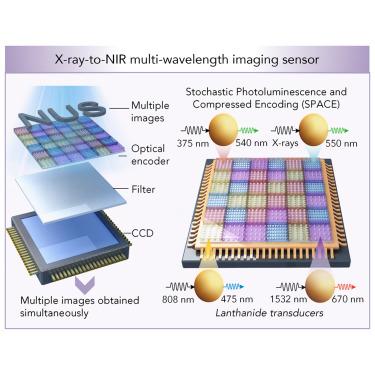Matter ( IF 18.9 ) Pub Date : 2024-03-13 , DOI: 10.1016/j.matt.2024.02.014 Luying Yi , Hong Qi Tan , Bo Hou , Xiaogang Liu

|
Multi-wavelength imaging is crucial for gaining detailed insights into the multi-depth or multi-wavelength information present in the scenes. However, conventional methods often have limitations, like costly and bulky components restricted to specific wavelength ranges. Here, we introduce an imaging technique named “stochastic photoluminescence and compressed encoding,” or SPACE. SPACE leverages randomly arrayed lanthanide transducers as photonic encoders to capture various excitation wavelengths in a single image, recorded by a charge-coupled device. This approach enables the reconstruction of multiple scenes from this encoded image across four wavelength channels: X-rays (0.089 nm), ultraviolet (375 nm), and two near-infrared bands (808 and 1,532 nm), with the ability to expand to more channels through multi-layer encoders. SPACE enables multi-channel imaging for depth visualization and multi-spectral X-ray analysis, offering broad multi-spectral sensitivity and on-chip compatibility. This makes it a versatile tool for applications in materials characterization, bioimaging, remote sensing, and astronomy.
中文翻译:

通过随机光致发光和压缩编码进行 X 射线到 NIR 多波长成像
多波长成像对于详细了解场景中存在的多深度或多波长信息至关重要。然而,传统方法通常具有局限性,例如昂贵且笨重的组件仅限于特定波长范围。在这里,我们介绍一种名为“随机光致发光和压缩编码”(SPACE)的成像技术。 SPACE 利用随机排列的镧系元素传感器作为光子编码器来捕获单个图像中的各种激发波长,并由电荷耦合设备记录。这种方法能够通过四个波长通道从该编码图像重建多个场景:X 射线 (0.089 nm)、紫外线 (375 nm) 和两个近红外波段(808 和 1,532 nm),并且能够扩展到通过多层编码器获得更多通道。 SPACE 可实现深度可视化和多光谱 X 射线分析的多通道成像,提供广泛的多光谱灵敏度和片上兼容性。这使其成为材料表征、生物成像、遥感和天文学应用的多功能工具。



























 京公网安备 11010802027423号
京公网安备 11010802027423号